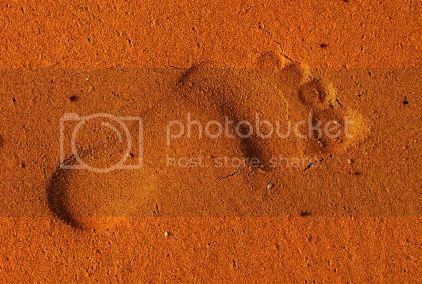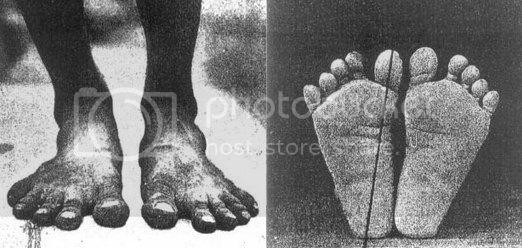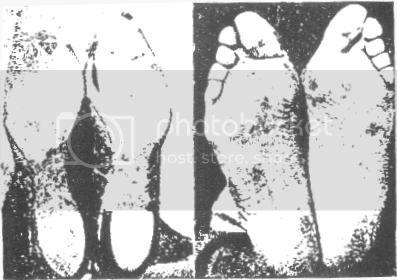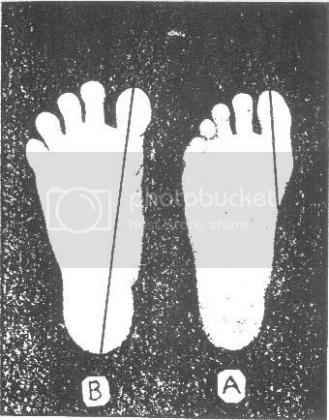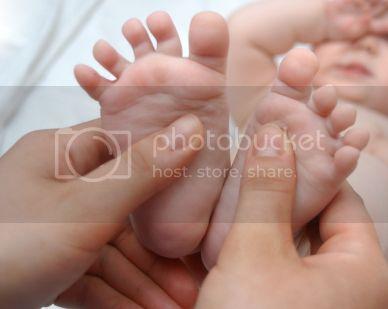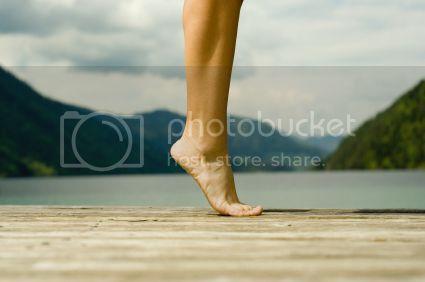
Wednesday, July 20, 2011
Breathalyzer
Workout:
800 m run
50 back extensions
50 mb twists
50 sit ups
3 RFT
How to Strengthen Your (Bare, Flat) Feet
by Mark Sisson
https://www.marksdailyapple.com/flat-feet-treatment/
"About 20% of adults have flat feet. A small subset of the population suffers from hereditary flat foot, but most of it is developed. Very few of us are actually born with flat foot. In this post I’ll explore what you can do to avoid flat feet in the first place, and if you already have them whether it is possible to reverse the damage.
Since publishing blog posts on ditching shoes, alternatives to going barefoot, and others I now receive regular reader emails like this one:
Dear Mark,
I’ve had flat foot all my life (18 years so far) and always wondered about the cause from an evolutionary stand point, and any negatives that might come from it. I vaguely remember the doctors subscribing foot supports and a lot of unnecessary products which I haven’t used in a decade. I don’t have any problems that I know of, but just wondering if there’s any alterations I should make to my workout routine to benefit me more? Thanks in advanced.
Ahmed
Great question, Ahmed.
First, how do we develop flat feet? Almost every online resource gives a few stock answers for the cause of flat foot. Most places say something like this:
Or this:
Okay, weakened muscles in the foot I can buy as a cause. In fact, it’s almost certainly one of the primary causes of flat foot. High heels aren’t doing us any favors, either, although I’d amend that one to include anything with even slightly-raised heels as a causative agent. I cannot, however, agree with the contention that lack of shoes without “proper arch support” is the problem; I’d even say that it’s the exact opposite. Try “Wearing shoes that do provide proper arch support” instead. Shoes do little else but provide an environment that our feet simply haven’t truly adapted to.
Our genes want us to be barefoot. In fact, it’s the only environment they know, having been born into a shoeless existence. On an individual scale, you could say we adapt to our shoes, but not on a genetic level. Evolutionarily, we’re still walking on the same bare feet Grok used to get around his environment. In fact, hominids have been obligate bipeds for over two million years. Our feet were arguably the first things to develop. Before the big brains, the complex tool making, and the language, our ancestors were walking upright on feet that looked remarkably similar to our own. But don’t tell that to the guys at Nike. They’re convinced those millions of years of natural selection still weren’t enough to produce a working, functional foot that doesn’t require manmade supportive footwear (unless, of course, you buy the Nike Free, in which case the lack of support is suddenly beneficial – awesome logic, huh?).
Before I get carried away on a tangential rant against athletic shoes, I’ll try to stick to the topic at hand. We know that shoes alter the structure and function of the foot. I mean, it sounds like plain common sense, but there’s also some concrete evidence. Back in 1905, an orthopedist named Dr. Philip Hoffman conducted a “Comparative Study of Barefooted and Shoe-Wearing Peoples” (don’t you just love old research?) and published his results in the American Journal of Orthopedic Surgery. He also took a ton of photos.
Here’s one of a foot that rarely – if ever – saw the inside of a shoe.
Note the wide toes, and how a straight line can be drawn through the axis. Looks pretty healthy and stable, right?
Now look at this photo of a pair of feet and the shoes they’re shoved into.
Notice the narrow structure and the cramped toes, especially the angle of the big toe. It’s pointing inward!
Shoe wearing acts quickly, too. Here, Hoffman snapped photos of two sets of feet.
Foot A is that of a child who has worn shoes for a mere three months, while Foot B is that of an adult who’s gone barefoot his whole life. Three months was all it took to drastically shape the child’s feet. Already his big toe is turning inward.
In the end, Hoffman concluded that of the “one hundred and eighty-six pairs of primitive feet examined, [he] did not find a single foot associated with the symptoms of weakness so common in adult shoe-wearing feet, which are weakened by the restraint the shoe exerts over function.” He also noticed that foot development was remarkably similar, in all populations, up until the introduction of foot wear. Shoes, it seems, have an undeniable ability to alter one’s natural foot structure.
But wait: there’s even more. Researchers in India found (PDF) that flat foot was far more prevalent among people who wore footwear before the age of six. Kids who ran around barefoot for most of their first six years – the formative years, it turns out – had better developed longitudinal arches and less flat foot. Among children who wore footwear on a regular basis, 8.2% suffered from flat foot (compared to 2.8% of barefoot kids). No other factors had comparable impacts. Adults didn’t have higher rates of flat foot than the kids, unless they reported wearing shoes as children. Why do we wear these things, anyway?
If you’ve got kids or are planning on it, you may want to take a good long look at their shoes – or lack thereof.
Okay, that’s all very compelling, but what does a guy like Ahmed do about his condition? Whether it was inherited (not likely) or developed through footwear usage, he’s still got to deal with a pair of flat feet. He can’t go back in time to age four and throw out his baby sneakers. He can’t erase the years and years of shoe-wearing, years that may have exacerbated his problem (kudos for ditching the orthotics, though!). Is Ahmed beholden to his situation? Are his feet forever altered?
No! Assuming his flat foot was developed, he’s still got the genetic potential to improve his feet and – at least partially – restore some of his natural structure and strength. You’ll still technically be flat footed, but you should be able to restore total functionality to your feet.
The first, perhaps most important step is to stay away from orthotics and shoes with “plenty of arch support.” Rather than help you solve your problem, shoes with arch supports prop you up and lead to weak, atrophied foot musculature. Your feet aren’t grasping, pulling, pushing, and flexing inside a pair of athletic trainers; they’re growing soft and growing weak. Fixing, or at least mitigating, your flat feet is going to require some serious foot strength.
Next, spend as much time as humanly possible with your bare feet. If you’re at home, remove your shoes as soon as you enter. If you’re heading out to take the dog on a walk, try circling the block in your bare feet. Mail’s come? Shoeless. Early morning paper? Barefoot. Living room workout? Do it without shoes on. You’ve got to learn to use your feet again, and the best way to do so is to simply live, eat, breath, and sleep barefoot.
Try toe running. When I haven’t done any serious barefoot work (which is very rare, actually; I’m almost always barefoot or in minimalist footwear) in awhile, I’ll hop on the treadmill in my socks (to reduce slippage) and do five or six minutes of light jogging. The catch is that I make sure to stay on my toes the entire time. This strengthens the ligaments and muscles (there are over a hundred of ‘em in the human foot) and prepares them for future activity.
Do toe spreads. Sit, stand, or lie down and fan your toes out as widely as possible. Create space between each toe. Hold this position for ten seconds, and repeat the exercise ten times daily per foot.
Point at things with your toes. Pick something, anything, in the room and point your toes at it. Now flex your foot. Hold it for five seconds, then release. Again, do this ten times per foot each day. For extra work, try tracing the alphabet with your feet in midair each day.
Get on your toes. Stand on your tippy-toes and just walk around for five minutes each day. Never let your heels touch the ground for the duration. Barefoot toe treadmill work is a worthy alternative.
Try side walking. Stand up (barefoot, of course) and get in a shoulder wide stance. Bend your knees slightly and roll onto the outer edges of your feet. Keep the weight on your outer feet and slowly raise up on your toes. You should feel your longitudinal arch stretching; once you do, hold that position for five seconds. Repeat five times each day.
Walk in sand. Sand is never the same. If you kick off your shoes and hit the grains (yeah, I just coined that phrase: “hit the grains”), you will be catapulting your virgin bare feet into a chaotic, ever-changing environment that will force them to adapt. Hyperbole aside, walking barefoot in the sand is a highly effective way to strengthen your feet.
I can’t stress this enough: go slowly. From the previous pictures, it’s obvious how much of an impact shoes can have on our bodies. For many of us, a lifetime of shoe wearing means the risk of overtraining our bare feet is possible, or even likely, if we don’t exercise caution. You don’t want to leap blindly into barefoot sprints with severely flat feet and risk injuring yourself even further, do you? Do the strengthening exercises before anything else.
Again, the damage may be done, and the flat feet may be permanent. I’m obligated to say it. There is, however, a lot of anecdotal evidence, especially on some of the barefoot running sites, that suggests people with flat feet can prosper without shoes (and even cure their condition), but there’s little in the way of actual, concrete evidence. We do know that shoes affect the structure and function of our feet; what we don’t know is whether the damage can be reversed. You can certainly strengthen your feet simply by removing your shoes and going barefoot as often as possible – and I highly doubt we’re forever beholden to an artificial adaptation. We often hear about people adopting the Primal Blueprint and turning their lives around in a month after eating the Standard American Diet for years, because our genes are hardwired to prefer certain things and our bodies can recover from an awful lot of abuse. Maybe our feet are the same way. Maybe actual structural changes can’t be completely overcome, but I’d be willing to wager that through careful, targeted foot exercises and a focus on barefoot living, we can make them almost irrelevant."
Breathalyzer
Warm up: 800 m run, 250 m row, 30 double unders (or 30 tuck jumps)
Workout:
800 m run
50 back extensions
50 mb twists
50 sit ups
3 RFT
How to Strengthen Your (Bare, Flat) Feet
by Mark Sisson
https://www.marksdailyapple.com/flat-feet-treatment/
"About 20% of adults have flat feet. A small subset of the population suffers from hereditary flat foot, but most of it is developed. Very few of us are actually born with flat foot. In this post I’ll explore what you can do to avoid flat feet in the first place, and if you already have them whether it is possible to reverse the damage.
Since publishing blog posts on ditching shoes, alternatives to going barefoot, and others I now receive regular reader emails like this one:
Dear Mark,
I’ve had flat foot all my life (18 years so far) and always wondered about the cause from an evolutionary stand point, and any negatives that might come from it. I vaguely remember the doctors subscribing foot supports and a lot of unnecessary products which I haven’t used in a decade. I don’t have any problems that I know of, but just wondering if there’s any alterations I should make to my workout routine to benefit me more? Thanks in advanced.
Ahmed
Great question, Ahmed.
First, how do we develop flat feet? Almost every online resource gives a few stock answers for the cause of flat foot. Most places say something like this:
Causes of Weak Arches:
Flat feet can be hereditary and present themselves at birth. For others the condition can occur as a result of mis-treating the feet – for example wearing high heels for prolonged periods of time, or wearing shoes with no support.
Flat feet or fallen arches can also result from:
- Weakened muscles in the foot due to aging
- Weakened muscles in the foot due to injury
Or this:
Causes:
- Weakened muscles due to aging or heavy strain placed on the feet.
- Standing or walking for long periods in high heels.
- Wearing shoes that don’t provide proper arch support.
Okay, weakened muscles in the foot I can buy as a cause. In fact, it’s almost certainly one of the primary causes of flat foot. High heels aren’t doing us any favors, either, although I’d amend that one to include anything with even slightly-raised heels as a causative agent. I cannot, however, agree with the contention that lack of shoes without “proper arch support” is the problem; I’d even say that it’s the exact opposite. Try “Wearing shoes that do provide proper arch support” instead. Shoes do little else but provide an environment that our feet simply haven’t truly adapted to.
Our genes want us to be barefoot. In fact, it’s the only environment they know, having been born into a shoeless existence. On an individual scale, you could say we adapt to our shoes, but not on a genetic level. Evolutionarily, we’re still walking on the same bare feet Grok used to get around his environment. In fact, hominids have been obligate bipeds for over two million years. Our feet were arguably the first things to develop. Before the big brains, the complex tool making, and the language, our ancestors were walking upright on feet that looked remarkably similar to our own. But don’t tell that to the guys at Nike. They’re convinced those millions of years of natural selection still weren’t enough to produce a working, functional foot that doesn’t require manmade supportive footwear (unless, of course, you buy the Nike Free, in which case the lack of support is suddenly beneficial – awesome logic, huh?).
The Evidence
Before I get carried away on a tangential rant against athletic shoes, I’ll try to stick to the topic at hand. We know that shoes alter the structure and function of the foot. I mean, it sounds like plain common sense, but there’s also some concrete evidence. Back in 1905, an orthopedist named Dr. Philip Hoffman conducted a “Comparative Study of Barefooted and Shoe-Wearing Peoples” (don’t you just love old research?) and published his results in the American Journal of Orthopedic Surgery. He also took a ton of photos.
Here’s one of a foot that rarely – if ever – saw the inside of a shoe.
Note the wide toes, and how a straight line can be drawn through the axis. Looks pretty healthy and stable, right?
Now look at this photo of a pair of feet and the shoes they’re shoved into.
Notice the narrow structure and the cramped toes, especially the angle of the big toe. It’s pointing inward!
Shoe wearing acts quickly, too. Here, Hoffman snapped photos of two sets of feet.
Foot A is that of a child who has worn shoes for a mere three months, while Foot B is that of an adult who’s gone barefoot his whole life. Three months was all it took to drastically shape the child’s feet. Already his big toe is turning inward.
In the end, Hoffman concluded that of the “one hundred and eighty-six pairs of primitive feet examined, [he] did not find a single foot associated with the symptoms of weakness so common in adult shoe-wearing feet, which are weakened by the restraint the shoe exerts over function.” He also noticed that foot development was remarkably similar, in all populations, up until the introduction of foot wear. Shoes, it seems, have an undeniable ability to alter one’s natural foot structure.
But wait: there’s even more. Researchers in India found (PDF) that flat foot was far more prevalent among people who wore footwear before the age of six. Kids who ran around barefoot for most of their first six years – the formative years, it turns out – had better developed longitudinal arches and less flat foot. Among children who wore footwear on a regular basis, 8.2% suffered from flat foot (compared to 2.8% of barefoot kids). No other factors had comparable impacts. Adults didn’t have higher rates of flat foot than the kids, unless they reported wearing shoes as children. Why do we wear these things, anyway?
If you’ve got kids or are planning on it, you may want to take a good long look at their shoes – or lack thereof.
What Can You Do About It?
Okay, that’s all very compelling, but what does a guy like Ahmed do about his condition? Whether it was inherited (not likely) or developed through footwear usage, he’s still got to deal with a pair of flat feet. He can’t go back in time to age four and throw out his baby sneakers. He can’t erase the years and years of shoe-wearing, years that may have exacerbated his problem (kudos for ditching the orthotics, though!). Is Ahmed beholden to his situation? Are his feet forever altered?
No! Assuming his flat foot was developed, he’s still got the genetic potential to improve his feet and – at least partially – restore some of his natural structure and strength. You’ll still technically be flat footed, but you should be able to restore total functionality to your feet.
The first, perhaps most important step is to stay away from orthotics and shoes with “plenty of arch support.” Rather than help you solve your problem, shoes with arch supports prop you up and lead to weak, atrophied foot musculature. Your feet aren’t grasping, pulling, pushing, and flexing inside a pair of athletic trainers; they’re growing soft and growing weak. Fixing, or at least mitigating, your flat feet is going to require some serious foot strength.
Next, spend as much time as humanly possible with your bare feet. If you’re at home, remove your shoes as soon as you enter. If you’re heading out to take the dog on a walk, try circling the block in your bare feet. Mail’s come? Shoeless. Early morning paper? Barefoot. Living room workout? Do it without shoes on. You’ve got to learn to use your feet again, and the best way to do so is to simply live, eat, breath, and sleep barefoot.
Try toe running. When I haven’t done any serious barefoot work (which is very rare, actually; I’m almost always barefoot or in minimalist footwear) in awhile, I’ll hop on the treadmill in my socks (to reduce slippage) and do five or six minutes of light jogging. The catch is that I make sure to stay on my toes the entire time. This strengthens the ligaments and muscles (there are over a hundred of ‘em in the human foot) and prepares them for future activity.
A Few Simple Exercises to Strengthen Your Feet
Do toe spreads. Sit, stand, or lie down and fan your toes out as widely as possible. Create space between each toe. Hold this position for ten seconds, and repeat the exercise ten times daily per foot.
Point at things with your toes. Pick something, anything, in the room and point your toes at it. Now flex your foot. Hold it for five seconds, then release. Again, do this ten times per foot each day. For extra work, try tracing the alphabet with your feet in midair each day.
Get on your toes. Stand on your tippy-toes and just walk around for five minutes each day. Never let your heels touch the ground for the duration. Barefoot toe treadmill work is a worthy alternative.
Try side walking. Stand up (barefoot, of course) and get in a shoulder wide stance. Bend your knees slightly and roll onto the outer edges of your feet. Keep the weight on your outer feet and slowly raise up on your toes. You should feel your longitudinal arch stretching; once you do, hold that position for five seconds. Repeat five times each day.
Walk in sand. Sand is never the same. If you kick off your shoes and hit the grains (yeah, I just coined that phrase: “hit the grains”), you will be catapulting your virgin bare feet into a chaotic, ever-changing environment that will force them to adapt. Hyperbole aside, walking barefoot in the sand is a highly effective way to strengthen your feet.
I can’t stress this enough: go slowly. From the previous pictures, it’s obvious how much of an impact shoes can have on our bodies. For many of us, a lifetime of shoe wearing means the risk of overtraining our bare feet is possible, or even likely, if we don’t exercise caution. You don’t want to leap blindly into barefoot sprints with severely flat feet and risk injuring yourself even further, do you? Do the strengthening exercises before anything else.
Again, the damage may be done, and the flat feet may be permanent. I’m obligated to say it. There is, however, a lot of anecdotal evidence, especially on some of the barefoot running sites, that suggests people with flat feet can prosper without shoes (and even cure their condition), but there’s little in the way of actual, concrete evidence. We do know that shoes affect the structure and function of our feet; what we don’t know is whether the damage can be reversed. You can certainly strengthen your feet simply by removing your shoes and going barefoot as often as possible – and I highly doubt we’re forever beholden to an artificial adaptation. We often hear about people adopting the Primal Blueprint and turning their lives around in a month after eating the Standard American Diet for years, because our genes are hardwired to prefer certain things and our bodies can recover from an awful lot of abuse. Maybe our feet are the same way. Maybe actual structural changes can’t be completely overcome, but I’d be willing to wager that through careful, targeted foot exercises and a focus on barefoot living, we can make them almost irrelevant."
